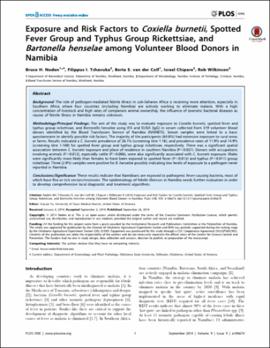| dc.contributor.author | Noden, Bruce H. | |
| dc.contributor.author | Tshavuka, Filippus I. | |
| dc.contributor.author | van der Colf, Berta E. | |
| dc.contributor.author | Chipare, Israel | |
| dc.contributor.author | Wilkinson, Rob | |
| dc.date.accessioned | 2022-04-12T13:53:04Z | |
| dc.date.available | 2022-04-12T13:53:04Z | |
| dc.date.issued | 2014-09-26 | |
| dc.identifier | oksd_noden_exposureandriskfactors_2014 | |
| dc.identifier.citation | Noden, B. H., Tshavuka, F. I., van der Colf, B. E., Chipare, I., & Wilkinson, R. (2014). Exposure and risk factors to Coxiella burnetii, spotted fever group and typhus group rickettsiae, and Bartonella henselae among volunteer blood donors in Namibia. PLoS ONE, 9(9), Article e108674. https://doi.org/10.1371/journal.pone.0108674 | |
| dc.identifier.uri | https://hdl.handle.net/11244/335190 | |
| dc.description.abstract | Background: The role of pathogen-mediated febrile illness in sub-Saharan Africa is receiving more attention, especially in Southern Africa where four countries (including Namibia) are actively working to eliminate malaria. With a high concentration of livestock and high rates of companion animal ownership, the influence of zoonotic bacterial diseases as causes of febrile illness in Namibia remains unknown. | |
| dc.description.abstract | Methodology/Principal Findings: The aim of the study was to evaluate exposure to Coxiella burnetii, spotted fever and typhus group rickettsiae, and Bartonella henselae using IFA and ELISA (IgG) in serum collected from 319 volunteer blood donors identified by the Blood Transfusion Service of Namibia (NAMBTS). Serum samples were linked to a basic questionnaire to identify possible risk factors. The majority of the participants (64.8%) had extensive exposure to rural areas or farms. Results indicated a C. burnetii prevalence of 26.1% (screening titre 1:16), and prevalence rates of 11.9% and 14.9% (screening titre 1:100) for spotted fever group and typhus group rickettsiae, respectively. There was a significant spatial association between C. burnetii exposure and place of residence in southern Namibia (P<0.021). Donors with occupations involving animals (P>0.012), especially cattle (P>0.006), were also significantly associated with C. burnetii exposure. Males were significantly more likely than females to have been exposed to spotted fever (P<0.013) and typhus (P<0.011) group rickettsiae. Three (2.9%) samples were positive for B. henselae possibly indicating low levels of exposure to a pathogen never reported in Namibia. | |
| dc.description.abstract | Conclusions/Significance: These results indicate that Namibians are exposed to pathogenic fever-causing bacteria, most of which have flea or tick vectors/reservoirs. The epidemiology of febrile illnesses in Namibia needs further evaluation in order to develop comprehensive local diagnostic and treatment algorithms. | |
| dc.format | application/pdf | |
| dc.language | en_US | |
| dc.publisher | Public Library of Science (PLoS) | |
| dc.relation.ispartof | PLoS ONE, 9 (9) | |
| dc.relation.uri | https://www.ncbi.nlm.nih.gov/pubmed/25259959 | |
| dc.rights | This material has been previously published. In the Oklahoma State University Library's institutional repository this version is made available through the open access principles and the terms of agreement/consent between the author(s) and the publisher. The permission policy on the use, reproduction or distribution of the material falls under fair use for educational, scholarship, and research purposes. Contact Digital Resources and Discovery Services at lib-dls@okstate.edu or 405-744-9161 for further information. | |
| dc.subject.mesh | Adolescent | |
| dc.subject.mesh | Adult | |
| dc.subject.mesh | Bartonella henselae | |
| dc.subject.mesh | Blood Donors | |
| dc.subject.mesh | Cat-Scratch Disease | |
| dc.subject.mesh | Coxiella burnetii | |
| dc.subject.mesh | Cross-Sectional Studies | |
| dc.subject.mesh | Female | |
| dc.subject.mesh | Humans | |
| dc.subject.mesh | Male | |
| dc.subject.mesh | Middle Aged | |
| dc.subject.mesh | Namibia | |
| dc.subject.mesh | Q Fever | |
| dc.subject.mesh | Rickettsia | |
| dc.subject.mesh | Rickettsia Infections | |
| dc.subject.mesh | Risk Factors | |
| dc.subject.mesh | Seroepidemiologic Studies | |
| dc.subject.mesh | Young Adult | |
| dc.title | Exposure and risk factors to Coxiella burnetii, spotted fever group and typhus group rickettsiae, and Bartonella henselae among volunteer blood donors in Namibia | |
| dc.date.updated | 2022-04-07T14:30:25Z | |
| osu.filename | oksd_noden_exposureandriskfactors_2014.pdf | |
| dc.description.peerreview | Peer reviewed | |
| dc.identifier.doi | 10.1371/journal.pone.0108674 | |
| dc.description.department | Entomology and Plant Pathology | |
| dc.type.genre | Article | |
| dc.type.material | Text | |
| dc.subject.keywords | Prevention | |
| dc.subject.keywords | Rare Diseases | |
| dc.subject.keywords | Infectious Diseases | |
| dc.subject.keywords | Vaccine Related | |
| dc.subject.keywords | Biodefense | |
| dc.subject.keywords | Emerging Infectious Diseases | |
| dc.subject.keywords | Vector-Borne Diseases | |
| dc.subject.keywords | 2.2 Factors relating to the physical environment | |
| dc.subject.keywords | Infection | |
| dc.subject.keywords | General Science & Technology | |
| dc.identifier.author | ORCID: 0000-0002-0096-370X (Noden, BH) | |
| dc.identifier.author | ScopusID: 6601968347 (Noden, BH) | |
| dc.identifier.author | ScopusID: 56382837400 (Tshavuka, FI) | |
| dc.identifier.author | ScopusID: 55482866500 (van der Colf, Berta E.) | |
| dc.identifier.author | ScopusID: 56147994900 (Chipare, Israel) | |
| dc.identifier.author | ScopusID: 57222416885 (Wilkinson, R) | |
